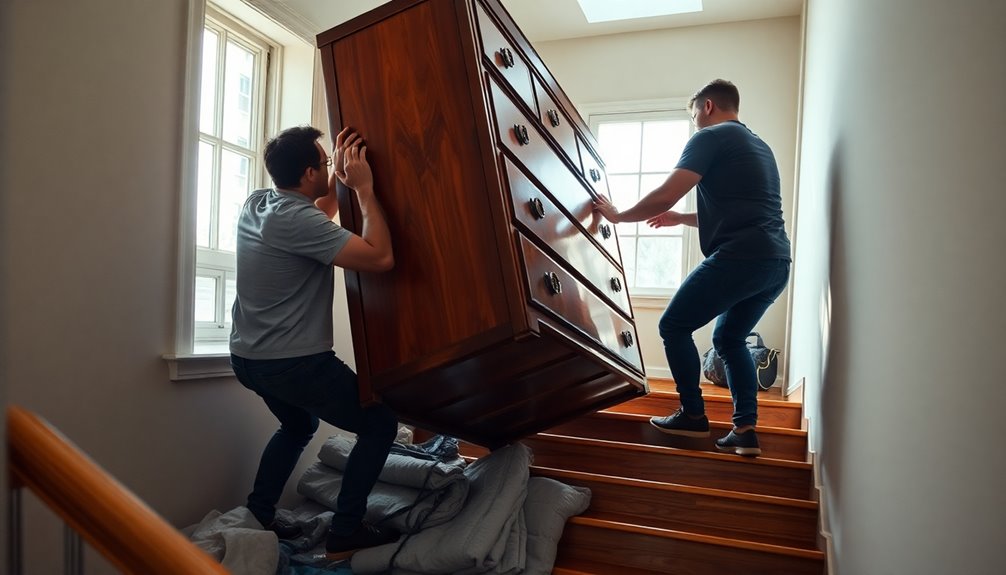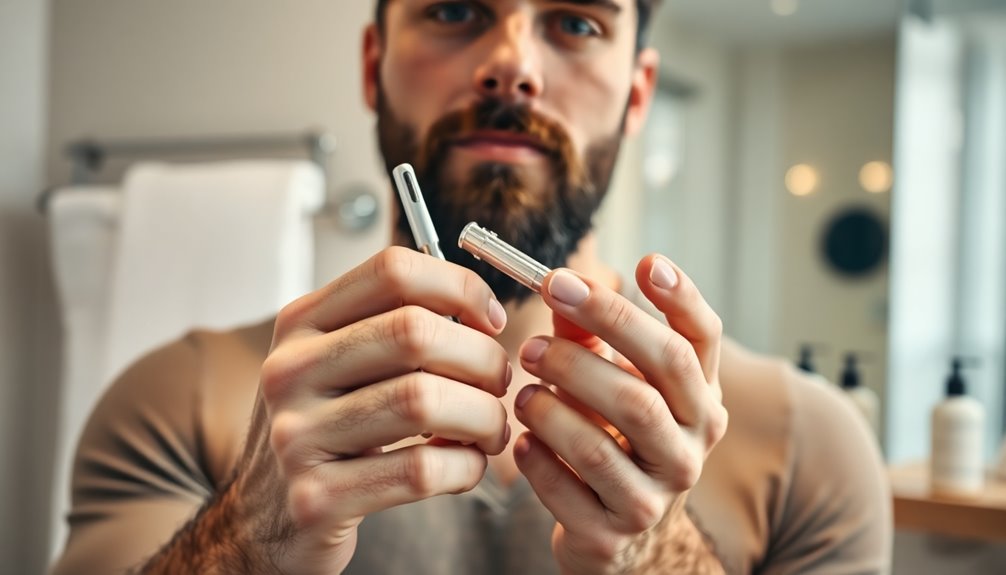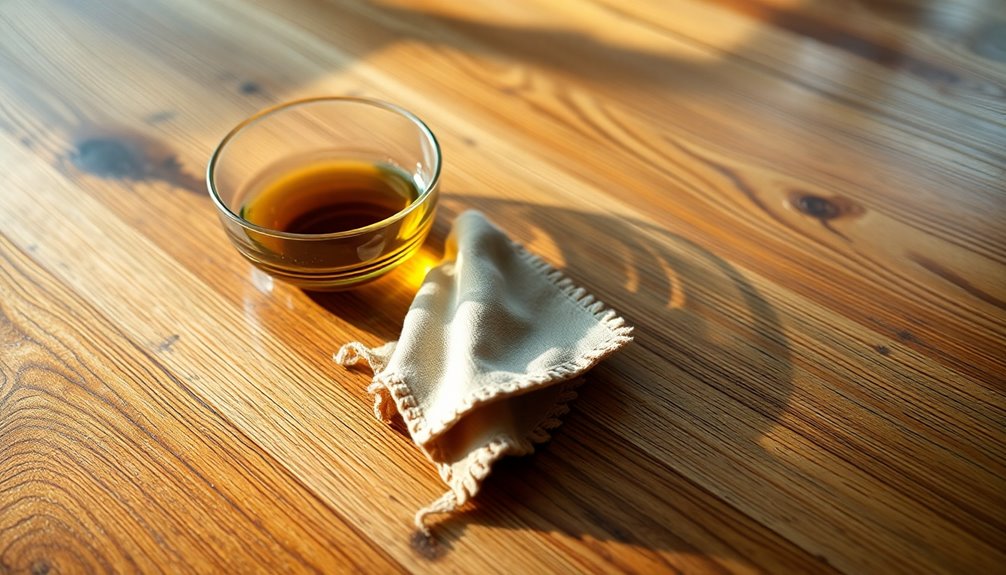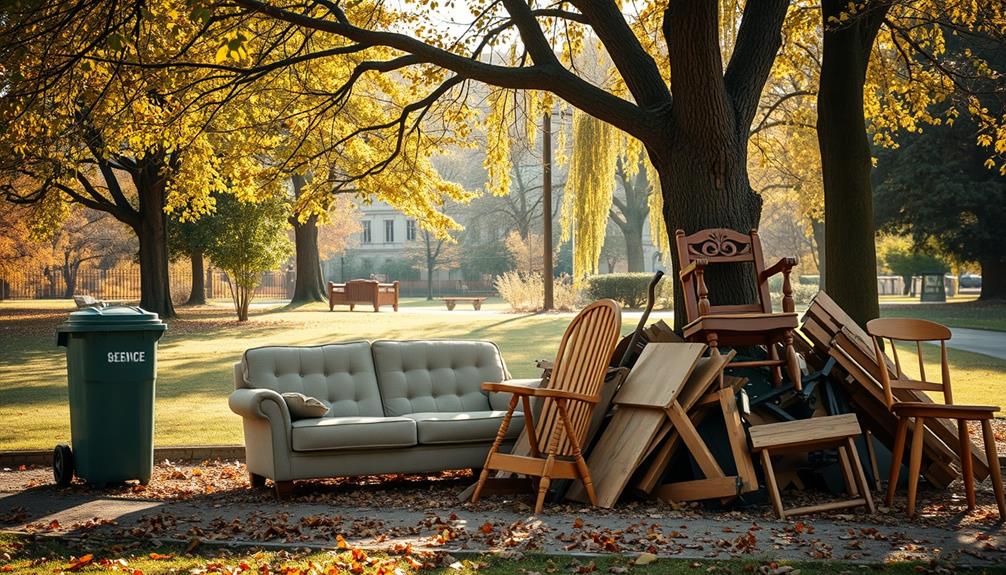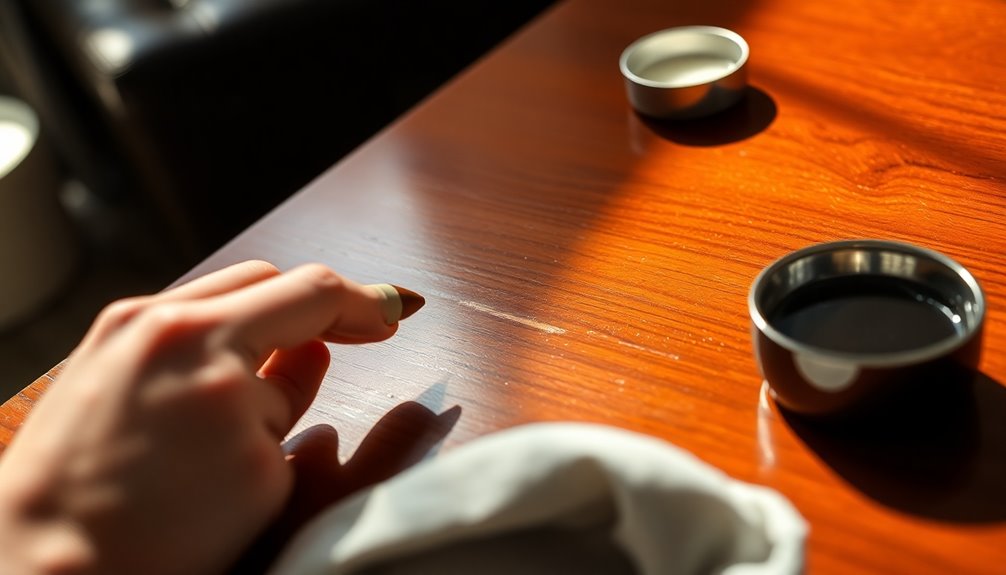To move heavy furniture down stairs safely, start by assessing its weight and dimensions. Clear the pathway of obstacles and use sliders to protect floors. If disassembly is possible, remove drawers and shelves to lighten the load. It’s best to have a partner; one should guide from the top while the other supports from the bottom. Maintain a firm grip and lower the furniture slowly, keeping it balanced. Wrapping the furniture in blankets will help avoid scratches. For more tips and effective techniques, stick around to explore additional strategies for a smoother move. When you reach the bottom, ensure that the area is secure before fully releasing the weight of the furniture. If you need to move heavy furniture upstairs safely, consider using a stair dolly or a moving strap for better leverage and control. Always communicate with your partner during the process to prevent accidents and ensure a coordinated effort.
Key Takeaways
- Assess the weight and size of the furniture, and choose the appropriate descent method for safe handling.
- Clear the pathway of obstacles and communicate a moving plan with all participants to ensure smooth movement.
- Use moving straps and a stair-climbing dolly, ensuring they can handle the load and are secured properly.
- Maintain a firm grip and lower furniture slowly, keeping it balanced while navigating stairs to prevent tipping.
- Take breaks as needed to avoid fatigue, and inspect furniture for damage after moving to address any issues.
Planning the Descent
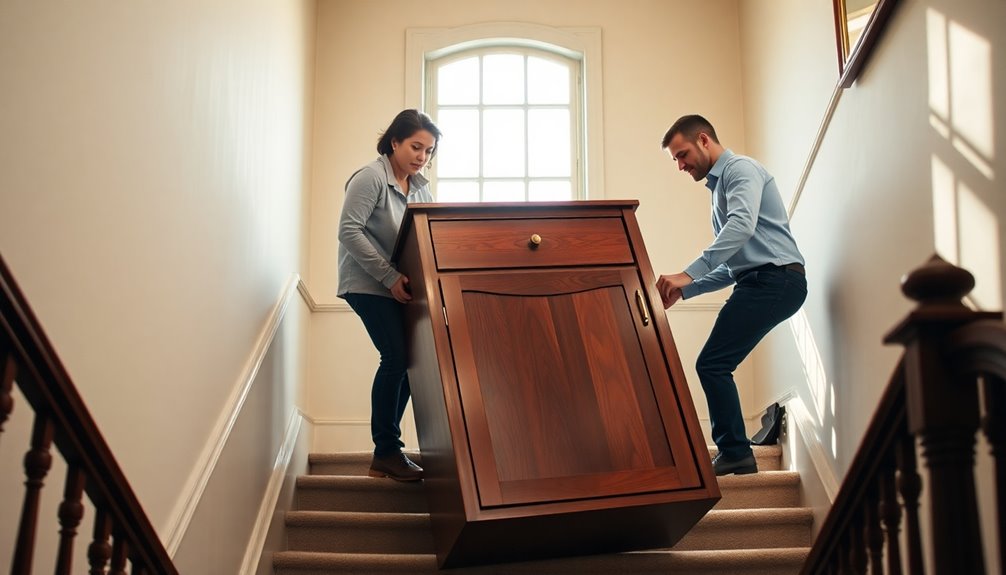
When moving heavy furniture down stairs, careful planning is essential to ensure a smooth and safe descent. First, you'll want to decide the optimal position for the furniture. Depending on the size and shape, it might be best to maneuver it horizontally, vertically, or diagonally. Next, choose your descent method—consider sliding the furniture on its back or bottom, using a stair-climbing dolly, or controlling its descent with a partner.
Before you start, empty the furniture to lighten the load and prevent items from falling out. Remove any protruding elements that might snag on railings or make turns difficult. Ensure all doors are tightly closed to avoid accidental openings during the move. It's also important to assess couch weight and dimensions to ensure proper handling during the descent.
Using proper equipment can make a huge difference. Furniture sliders can help reduce friction, while a hand truck or shoulder dolly will distribute weight evenly. Secure the furniture with ratchet straps, and use blankets or protective covers to prevent damage to both the furniture and the staircase. Finally, keep the heavier end going down first to minimize tipping risk, and always ensure you have enough manpower for the task at hand.
Disassembling the Furniture
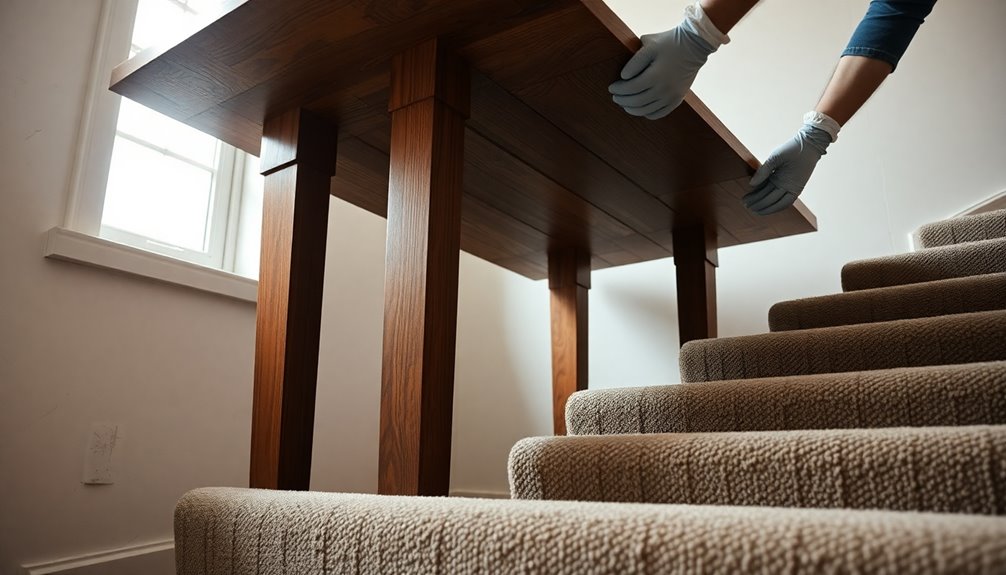
Disassembling heavy furniture can make your move down the stairs much simpler and safer. Start by measuring your furniture, doorways, hallways, and the moving truck to identify what needs disassembly. Accurate measurements help you avoid surprises during the move, so take your time here.
Next, clean and empty the furniture, which makes disassembly easier and reduces its weight. Remove drawers, shelves, and detachable panels to lighten the load. Don't forget to detach legs from sofas, dressers, and tables, and unscrew hinges to take off doors. Wrap these fragile parts in blankets or bubble wrap for protection.
When it comes to complex pieces, use tools like screwdrivers and pliers to carefully disassemble frames. Use resealable bags to keep screws and bolts organized in labeled bags to avoid confusion later.
Finally, take a photograph of each furniture piece before disassembly, so you have a guide for reassembly. By storing disassembled parts together with their corresponding furniture items, you'll streamline the entire moving process.
Using Furniture Sliders
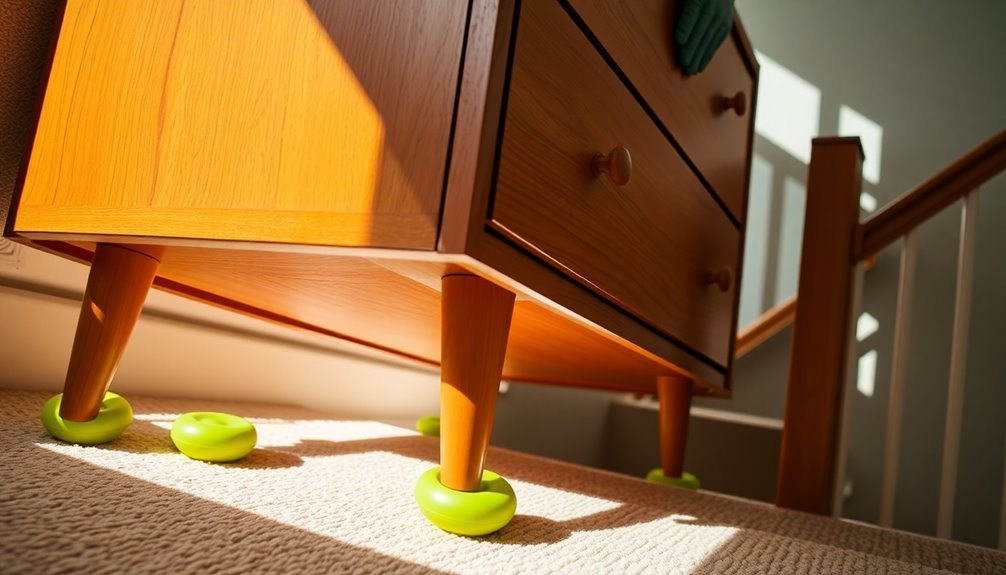
Using furniture sliders can transform the daunting task of moving heavy items down stairs into a more manageable process. Start by gathering the necessary tools, including sliders made of plastic, rubber, or felt. Make sure to choose the right type for your floor surface—felt for hard floors and foam for carpet. Before you begin, remove any items from the furniture to lighten the load and prevent damage.
Next, tilt or lift the furniture gently to slip a slider under each leg, ensuring they're centered to prevent slipping. If available, use metal handles to help push or pull the furniture, and check that the sliders are aligned for even weight distribution. These sliders are designed to protect carpets and hard floors during the moving process.
As you move the furniture down the stairs, assess its weight and the dimensions of the stairwell. Make sure to measure doorways and landings to avoid getting stuck. Push the furniture from the lower section to reduce friction and keep the heaviest end going down first to minimize tipping. Communicate clearly with any partners and take slow, deliberate steps. This method not only protects your furniture but also safeguards your floors from damage.
Utilizing Moving Straps
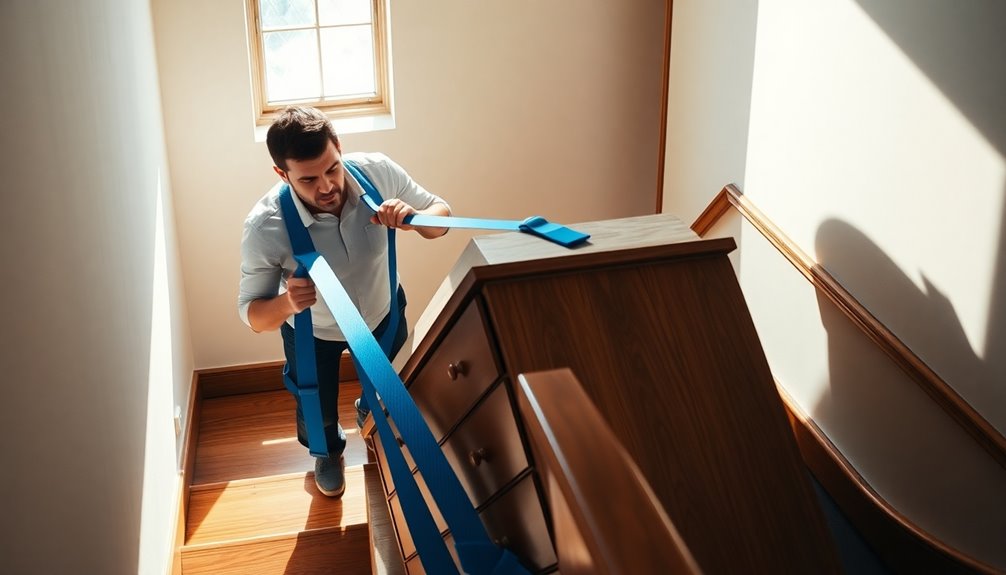
After you've prepared your furniture with sliders, consider employing moving straps to enhance your lifting technique. These straps can significantly ease the burden of moving heavy items down stairs. Start by positioning the straps correctly; place them under the object, centering them near the outside edge for stability. If your furniture has legs, run the straps parallel along the inner side. For lopsided pieces, use an x-pattern to secure everything.
When you're ready to lift, communicate with your moving partner. Use leverage to distribute the weight, which minimizes bending and the risk of injury. Always keep the heaviest end of the furniture going down first to prevent tipping. Remember to bend your knees and keep your back straight as you move. Using moving straps can significantly decrease the risk of injury during moving.
As you lower the item, do it in tandem with your partner, maintaining that same posture. Once down, carefully remove the straps, ensuring you don't trip over anything. Stay aware of your surroundings to avoid obstacles. If you start feeling fatigued, take a break—moving heavy furniture is a marathon, not a sprint. Following these steps will make your moving experience much more manageable.
Employing a Stair-Climbing Dolly
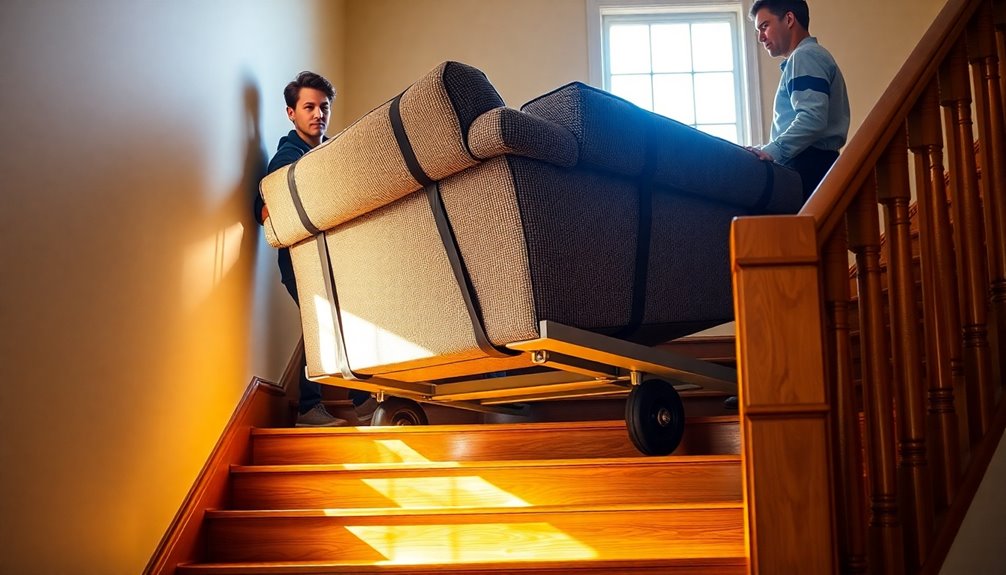
Moving heavy furniture down stairs can be daunting, but employing a stair-climbing dolly makes the task much easier and safer. These specialized dollies come in various types, including powered models with electric motors that can handle loads up to 1,200 pounds. Brands like Escalera, New Haven, and Zonzini offer options with unique features such as tank-like treads and automatic load leveling, allowing you to navigate stairs of any height with ease. Additionally, using equipment beyond its capacity increases the risk of injury, so always choose a dolly that suits your specific load.
When using a stair-climbing dolly, ensure the load is centered and secured with tie-down straps. For ascending, roll the dolly backward toward the stairs and pull it up. While descending, stand behind the dolly, tilting it toward you. It's wise to have helpers assist, especially for larger items.
Be cautious on curved staircases, as they can be trickier to navigate. Additionally, consider using accessories like big wheel attachments for improved stability. With the right dolly and careful operation, you can significantly reduce the risk of injury and the effort required, making your move much more efficient.
Controlled Lowering Techniques
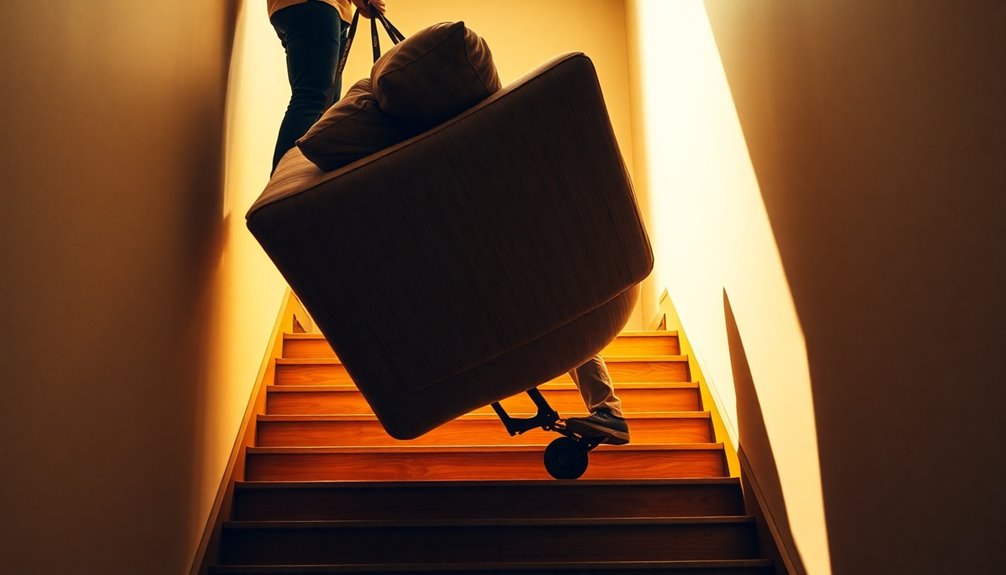
When it comes to safely lowering heavy furniture down stairs, controlled techniques are crucial to prevent accidents and injuries. Start by assessing the staircase for any hazards and measuring both the furniture and stairway to ensure a smooth descent. Communicate clearly with your team, assigning roles to maintain balanced control—one person at each end is ideal.
As you begin the descent, utilize gravity to your advantage. Tilt the furniture back slightly, allowing gravity to assist while you maintain a firm grip. Use your body weight to counterbalance the load, bending your knees to act as shock absorbers. This technique not only reduces strain but also helps you control the descent more effectively. Additionally, it's essential to seek assistance from at least two people to ensure a safe and efficient moving process.
It's important to coordinate actions with your team. Have a helper a few steps ahead to guide the process and communicate any adjustments. Take breaks as needed, setting the furniture down securely on the stairs to regroup. Lastly, ensure safety by covering banisters and corners with padding and wrapping the furniture to prevent damage. With these controlled lowering techniques, you'll successfully navigate the stairs without risking injury or damage.
Frequently Asked Questions
What if My Furniture Won't Fit Through the Door?
If your furniture won't fit through the door, don't panic. First, measure the furniture and doorframe to identify the issue. You might want to try different angles or temporarily remove the door for more space. Disassembling the furniture can also help, so take off any detachable parts. If all else fails, consider calling in professional movers who have the experience and tools to handle tricky situations safely and efficiently.
How Do I Protect My Walls During the Move?
To protect your walls during the move, start by using blankets or cardboard as buffers in tight spots. Tape cardboard sheets to the walls to prevent scratches, and consider installing temporary corner guards in high-traffic areas. Cover banisters and corners with padding to absorb impacts. Wrap any sharp edges of your furniture in protective materials, and use furniture sliders to minimize dragging, ensuring your walls stay safe throughout the process.
Can I Move Heavy Furniture Alone?
You can try moving heavy furniture alone, but it's risky. You might strain your muscles or injure your back, especially if the weight catches you off guard. It's easy to underestimate how cumbersome heavy items can be. If you decide to go solo, use proper lifting techniques, take breaks, and consider using tools like a dolly. However, enlisting help from friends or hiring professionals is a much safer and smarter option.
What Tools Should I Have on Hand for the Move?
When you're preparing for a move, it's essential to have the right tools on hand. Start with hand trucks and dollies to easily transport heavy items. Lifting straps can help distribute weight and reduce strain. Don't forget moving blankets to protect your furniture and floors. If you're dealing with stairs, consider stair rollers or portable ramps for easier navigation. These tools will make your move smoother and safer, ensuring everything arrives intact.
How Do I Prevent Injury While Moving Furniture?
To prevent injury while moving furniture, you should always lift with your legs, not your back. Keep the furniture close to your body for better stability, and avoid twisting while lifting. If the load feels too heavy, don't hesitate to ask for help or use tools like dollies. Take regular breaks, stay hydrated, and wear sturdy shoes to reduce tripping hazards. Listening to your body is crucial, so know your limits.
Conclusion
Moving heavy furniture down stairs can be a daunting task, but with the right preparation and tools, you can do it safely and efficiently. Remember to plan your descent, disassemble when possible, and use furniture sliders or moving straps for extra support. If you have a stair-climbing dolly, take advantage of it to ease the load. By employing controlled lowering techniques, you'll protect both yourself and your furniture, making the process much smoother. Happy moving!
